Please sign in with Google to view the map.
Sign in with GooglePicasso Museum Barcelona | 4000+ Works in El Born Palaces
Explore Picasso’s early works, ceramics, and cubism in 5 medieval palaces. Tips, tickets, free entry days, and guided tours in El Born, Barcelona
About the Picasso Museum in Barcelona
The Picasso Museum Barcelona, located in the heart of the El Born District, is one of the city’s most visited art history museums. Opened in 1963, it houses over 4,000 works by Pablo Picasso, offering a deep dive into the artist’s formative years and creative evolution. This is the best place to explore Picasso’s early works in Barcelona, including paintings, drawings, and ceramics that shaped his legacy.
Set within five interconnected medieval palaces on Montcada Street, the museum is as much an architectural treasure as it is an artistic one. These Gothic Catalan buildings — including Palau Berenguer d'Aguilar and Palacio Meca — feature open courtyards, noble floors, and centuries of history. The museum’s layout and ambiance make it a standout among Barcelona’s cultural landmarks.
Whether you're an art lover, history buff, or curious traveler, the Picasso Museum highlights include rare sketches, early portraits, and pieces from his Blue Period and Rose Period. It’s a must-visit stop on any Barcelona art itinerary.
Architecture of the Picasso Museum Barcelona
The Picasso Museum is not only a treasure trove of art — it’s also one of the most remarkable architectural landmarks in Barcelona. Located on Montcada Street in the El Born District, the museum occupies five interconnected medieval palaces, each with its own rich history and distinct character.
These buildings — including Palau Berenguer d'Aguilar, Casa del Baró de Castellet, and Palacio Meca — date back to the 13th and 14th centuries and were once homes to wealthy merchants and noble families. Their layout follows the classic Gothic Catalan style, featuring central courtyards, external staircases, and noble floors that now house Picasso’s works.
The museum’s unique setting makes it one of the few places where visitors can admire Picasso’s early works while walking through authentic medieval architecture. The fusion of historic palatial design with modern exhibition spaces offers a truly immersive experience, making the Picasso Museum building history a highlight in itself.
Each palace has been carefully restored to preserve its original features — from stone archways and frescoed ceilings to timber beams and Roman foundations. Together, they form a stunning backdrop for one of the most important Picasso collections in Spain.
- Palau Berenguer d'Aguilar – Carrer de Montcada 15: The first of the Picasso Museum’s medieval palaces, this 13th–14th century residence once belonged to nobles of the Court of Aragon. It features classic Gothic Catalan architecture and was acquired by the City Council in 1953 to begin the museum’s expansion.
- Casa del Baró de Castellet – Carrer de Montcada 17: A 13th-century Gothic palace in Barcelona that passed through noble and bourgeois families before becoming part of the museum. Its name honors the Baron de Castellet, a title granted in 1797 by King Carlos IV of Spain.
- Palacio Meca – Carrer de Montcada 19: Originally built in the 13th–14th centuries and remodeled in the 18th, this palace is the largest on the block. It was restored after damage in the 1714 War of Spanish Succession and became part of the Picasso Museum complex in 1982.
- Casa Mauri – Carrer de Montcada 21: A historic building with industrial roots, Casa Mauri was owned by the Rocha family in the 14th century and later by the Mauri bakery. It was integrated into the Museu Picasso Barcelona in 1999, adding to the museum’s architectural diversity.
- Palau Finestres – Carrer de Montcada 23: Built atop a former Roman necropolis, this 13th-century palace belonged to the Marimon family and was annexed to Casa Mauri in the 19th century. It became part of the museum in 1970 and reflects the layered architectural history of Montcada Street.
Image Gallery For Barcelona Picasso Museum
Click on any of the 10 images to open full screen gallery player. Note that viewing images is subject to our Fair Use Policy.
Visiting the Picasso Museum Barcelona
Exploring the Picasso Museum in El Born is a must for anyone following a Barcelona art itinerary. The museum is thoughtfully organized into galleries that showcase Picasso’s artistic evolution — from his early academic sketches to his Blue Period, Rose Period, and Cubist masterpieces. Each room includes interpretive plaques and an audio guide, so don’t forget to bring your headphones for a deeper experience.
Among the Picasso Museum highlights are rare ceramics, early portraits, and personal items that reveal the artist’s creative process. Many rooms retain their original palatial features, including frescoed ceilings and Gothic arches — so be sure to look up as you explore.
Photography is permitted for personal use without flash, but publishing images requires prior written permission. Respect the Picasso Museum photography rules to preserve the integrity of the artworks and the museum’s ambiance.
Due to its popularity, the museum can get crowded — especially during free entry days and weekends. For a relaxed visit, consider booking skip-the-line tickets or arriving early on weekdays. Lunchtime visits often offer a quieter experience with fewer crowds.
- Tuesday to Sunday including public holidays: 10:00 am to 7:00 pm
- Closed: Mondays, 1st January, 1st May, 24th June, 25th December
- 5th January: 10:00 am to 5:00 pm. 24th and 31st December: 10:00 am to 2:00 pm
Barcelona Picasso Museum opening hours
What to See in the Picasso Museum Barcelona
The Picasso Museum in Barcelona offers a rich and chronological journey through the artist’s life, making it one of the most comprehensive collections of Picasso’s early works. Visitors can explore over 4,000 pieces, including paintings, drawings, engravings, and a remarkable ceramics collection that showcases his versatility.
Among the Picasso Museum highlights are works from his formative years in Barcelona, including portraits of family members and studies from his time at the Llotja School of Fine Arts. You’ll also find rare pieces from his Blue Period and Rose Period, which reflect his emotional and stylistic evolution.
The museum also features examples of Analytic and Synthetic Cubism, giving insight into Picasso’s groundbreaking contributions to modern art. Don’t miss the original copy of Arte Joven, the magazine he co-founded in Madrid, and several works created during his stays in Horta de Sant Joan — a pivotal moment in his artistic development.
Each gallery is carefully curated to reflect a distinct phase of Picasso’s career, making it easy to follow his transformation from a classically trained painter to a revolutionary force in 20th-century art. Whether you’re drawn to his early sketches or his bold cubist compositions, the museum offers a deep and rewarding experience for art lovers.
Pablo Picasso Biography
Picasso’s Early Career and Life in Paris
- 1898: Picasso began signing his works as "Pablo Ruiz Picasso" and later "Pablo R. Picasso." He chose his maternal surname to distinguish himself artistically, a name his Barcelona friends often used.
- 1900: Picasso moved to Paris, then the epicenter of European art. He shared a modest apartment with poet Max Jacob, enduring poverty and cold while developing his style. Many early works were lost — burned for warmth.
- 1901: In Madrid, Picasso co-founded the magazine Arte Joven with Francisco de Asís Soler, contributing illustrations that reflected social hardship. A copy of this rare publication is on display at the Picasso Museum Barcelona.
Picasso’s Blue Period (1901–1904) features melancholic works in shades of blue and green, inspired by personal loss and poverty.
Picasso’s Rose Period (1904–1906) introduced warmer tones and subjects like circus performers and harlequins, reflecting a more optimistic phase.
African-Influenced Period (1907–1909) began after Picasso’s visit to the ethnographic museum at Palais du Trocadéro in Paris, where African masks and sculptures deeply impacted his style.
Analytic Cubism (1909–1912) was developed with Georges Braque, using muted tones and fragmented forms to explore multiple perspectives.
Synthetic Cubism (1912–1919) introduced collage into fine art, combining newspaper clippings, wallpaper, and painted elements into unified compositions.
Picasso’s Mature Years
During World War I, Picasso traveled to Italy and adopted a neoclassical style influenced by Raphael and Ingres. In the 1930s, the Minotaur motif replaced the harlequin in his work, reflecting his engagement with surrealism.
In 1939–1940, the Museum of Modern Art in New York held a major retrospective that cemented Picasso’s global reputation. During World War II, he remained in Nazi-occupied Paris, continuing to work despite harassment and material restrictions.
Between 1935 and 1959, Picasso wrote over 300 poems and two plays, revealing a lesser-known side of his creativity. In 1944, he began a relationship with art student Françoise Gilot, with whom he had two children. Their eventual separation deeply affected him.
Later Works and Final Years
In 1949, Picasso exhibited at the 3rd Sculpture International in Philadelphia. He also appeared in films, including Jean Cocteau’s Testament of Orpheus (1960), and helped create Le Mystère Picasso (1955).
In 1962, he was commissioned to design the Chicago Picasso, a 15-meter public sculpture unveiled in 1967. Picasso refused payment, donating the work to the people of Chicago.
From 1968 to 1971, Picasso produced hundreds of expressive paintings and copperplate etchings. Initially dismissed, these late works are now recognized for their boldness and emotional depth.
Picasso’s Personal Life
Picasso’s relationships were often turbulent. In 1951, he had a brief affair with Geneviève Laporte while still involved with Gilot. His later works frequently depicted older men and younger women, reflecting themes from his personal life.
Jacqueline Roque, whom he met at the Madoura Pottery in Vallauris, became his second wife in 1961 and remained with him until his death. They lived in several villas in southern France, including Mas Notre-Dame-de-Vie in Mougins.
Pablo Picasso died on 8 April 1973 at age 91 in Mougins, France. He is buried at the Château of Vauvenargues near Aix-en-Provence. After his death, Jacqueline Roque, devastated by grief, took her own life in 1986.
Accessibility and What to Bring
The Picasso Museum Barcelona is fully accessible to visitors with reduced mobility. There is an elevator connecting the ground and first floor galleries, and guide dogs are welcome throughout the museum. Although the museum doesn’t specify stroller policies, the spacious layout and wide corridors make it generally stroller-friendly.
Visitors are advised to bring only small bags or daypacks, as large backpacks and oversized items are not permitted. There is no cloakroom for bulky luggage, so travel light to avoid delays at entry.
For the best experience, don’t forget to bring headphones for the audio guide, which offers detailed commentary on Picasso’s life and works. Photography is allowed for personal use without flash, but publishing images requires prior permission.
There are no bicycle anchorage points directly outside the museum. The nearest secure bike parking is located at Carrer de Princesa 20, though visitors should be cautious — bicycle theft is common in this area.
Tickets for Barcelona Picasso Museum
The Picasso Museum in Barcelona offers several ticket options depending on your visit style. Free entry is available on Thursday afternoons from 16:00h to 19:00h, the first Sunday of each month, and during open-door days on 12th and 13th February, 18th May, and 24th September. These are popular times, so expect long queues unless you book in advance.
Having tried to visit on a free day, I found the line stretching up Montcada Street and decided to skip it. Due to high demand, free tickets must be reserved online up to four days in advance via the Picasso Museum official website.
For a smoother experience, I recommend visiting during quieter hours — like weekday lunchtimes. I visited on a Wednesday at 13:30h without pre-booking and found the museum pleasantly uncrowded, allowing time to enjoy the galleries without pressure or pacing.
Picasso Museum ticket prices start at 12 € for general admission. For access to temporary exhibitions, the full ticket is 19 €. Tickets can be purchased online or at the museum entrance, but booking ahead is advised during peak seasons.
For a deeper understanding of Picasso’s work, consider a guided tour with an art historian. These tours offer insights into the artist’s life, techniques, and the meaning behind key pieces — ideal for art lovers and curious travelers alike.
Getting to the Picasso Museum Barcelona
Address: Carrer de Montcada 15–23, 08003 Barcelona, Spain
The Picasso Museum is located in the heart of El Born, one of Barcelona’s most historic and artistic neighborhoods. It’s easily accessible by public transport and makes a perfect stop on a cultural walking route through the Gothic Quarter.
Nearest Metro: Jaume I (L4 – Yellow Line) is just a 3-minute walk from the museum. From the station, follow signs toward Carrer de la Princesa and turn onto Carrer de Montcada, where the museum’s five medieval palaces are located.
For unlimited travel across the city, consider using a T-Casual card or the Hola Barcelona Travel Card, which offers great value for visitors.
The museum entrance is tucked into a narrow street behind the Santa Maria del Mar Basilica, making it a scenic and culturally rich destination to explore on foot.
Map for the Picasso Museum Barcelona
Weather for Picasso Museum Barcelona
Where to stay near Picasso Museum Barcelona
Nearby Attractions to Picasso Museum Barcelona
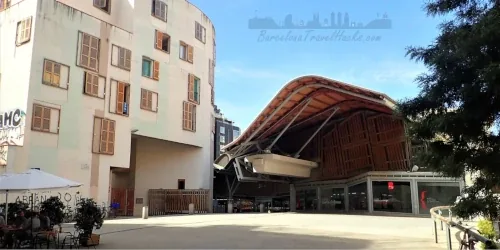 METRO
METRO
Santa Caterina Market | Barcelona’s Colorful Local Food Market
Explore Santa Caterina Market in El Born — a vibrant food hub with rooftop architecture, historic ruins, and fresh produce in the heart of Barcelona’s old town
Read more >
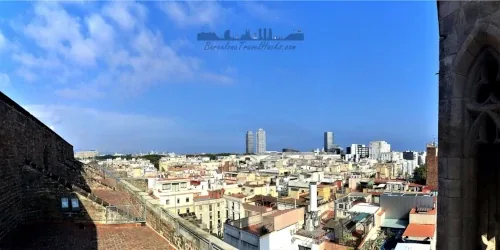 METRO
METRO
Santa María del Mar Cathedral | Gothic Basilica in El Born
Explore Barcelona’s Cathedral of the Sea. Free entry or guided rooftop tour with crypt access. Pure Catalan Gothic architecture in the heart of El Born
Read more >
 METRO
METRO
Fossar de les Moreres | Memorial to Catalonia’s Fallen
Visit Barcelona’s solemn memorial square honoring the 1714 siege victims. Eternal flame, floral tributes, and Catalan history in El Born
Read more >
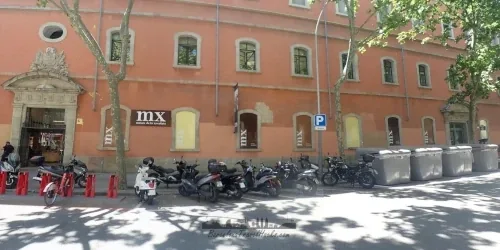 METRO
METRO
Museu de la Xocolata – Barcelona Chocolate Museum & School
Discover the origins of chocolate in South America and its journey to Europe. Explore myths, medicinal uses, and traditions at Barcelona’s Chocolate Museum
Read more >
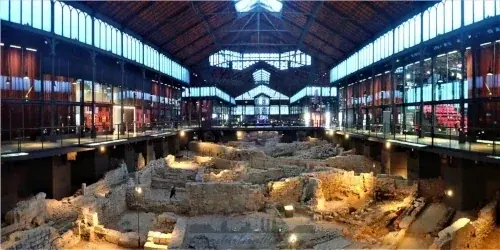 METRO
METRO
Born Cultural Centre Barcelona | Ruins, Museum & Guided Tours
Explore 1714-era ruins beneath a 19th-century market at El Born Cultural Centre. Free entry, guided tours, and powerful stories of Barcelona’s past
Read more >
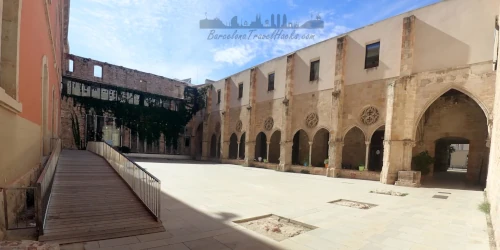 METRO
METRO
Sant Agustí Monastery Ruins & Civic Centre – Café & Courtyard
Historic monastery ruins turned civic centre and café in El Born. Discover a quiet courtyard, brunch spot, and links to the Citadel Fortress and Chocolate Museum
Read more >
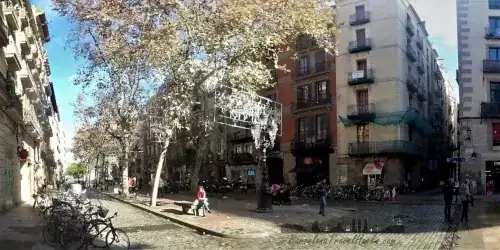 METRO
METRO
Passeig del Born | Historic Boulevard & Nightlife in El Born
Explore Barcelona’s medieval boulevard with cannonball history, boutique shopping, and top cocktail bars. From cathedral to market, day and night
Read more >
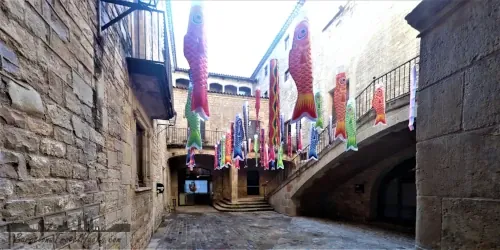 METRO
METRO